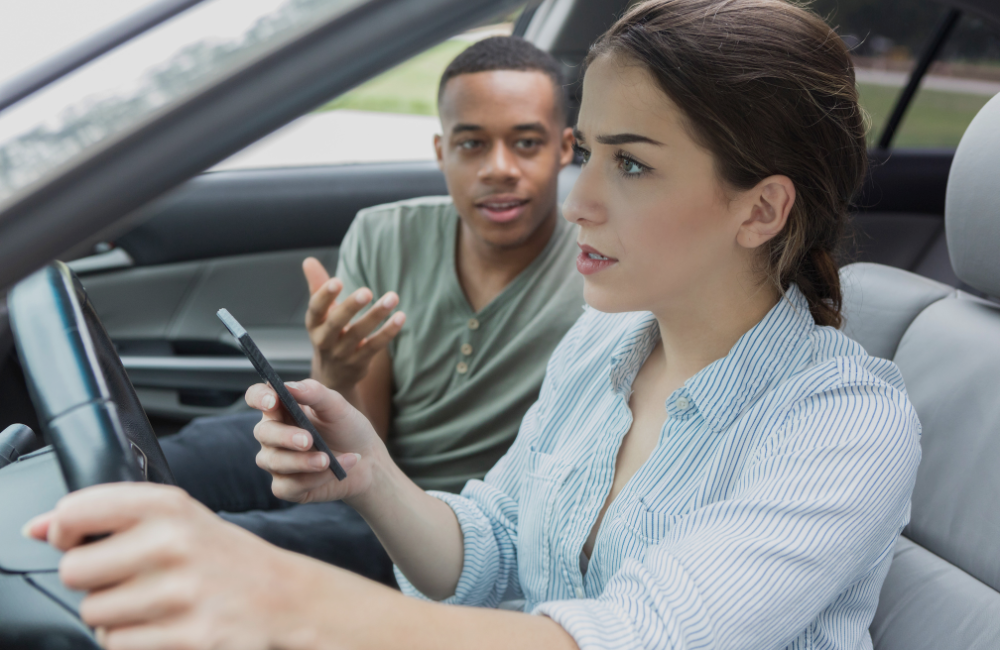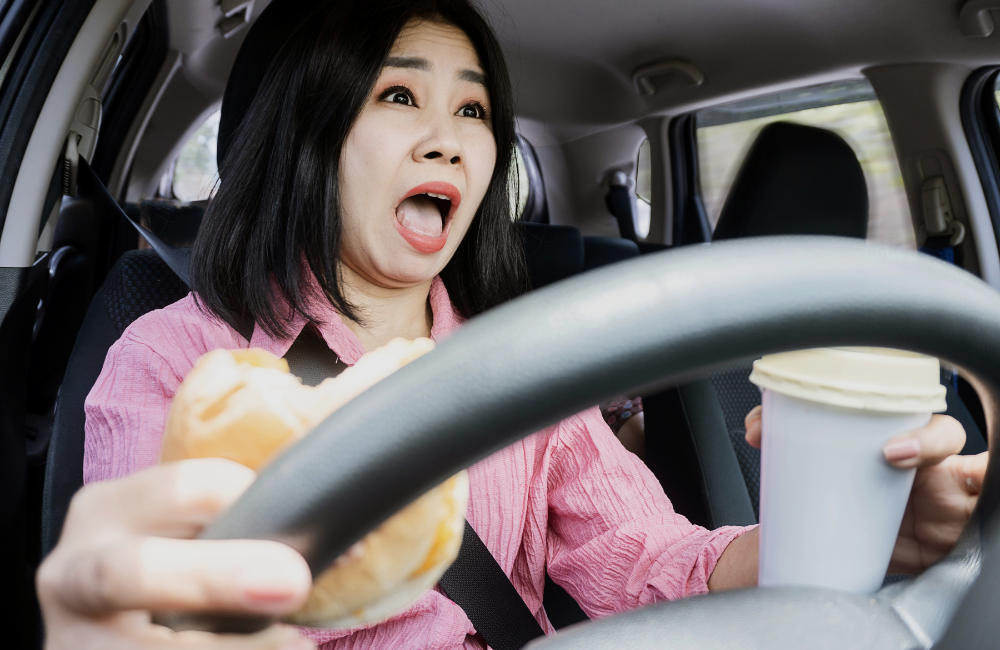Learn About Driving Distractions That Contribute to Florida Auto Accidents
April marks Distracted Driving Awareness Month, a crucial time to highlight the risks and realities of what can happen when our attention strays behind the wheel. In Florida, where bustling highways meet scenic routes, the dangers of driving distractions are ever-present and can lead to severe consequences. This article explores the ten common distractions that contribute significantly to auto accidents across the Sunshine State. Understanding these can help drivers make better choices and potentially save lives.
Key Statistics and Facts: Understanding the Impact of Distracted Driving on Auto Accidents
About 3,000 People Die in Auto Accidents Due to Distracted Driving Every Year
Each year, more than 3,000 lives are lost in car accidents attributed to distracted driving. This sobering statistic represents approximately 8% to 9% of all fatal motor vehicle collisions nationwide.
3,142 People Died Because of Distracted Driving in 2020
In the year 2020 alone, distracted driving contributed to 3,142 fatalities in auto accidents. Among these tragic incidents, 396 deaths occurred due to a driver using a cell phone at the time of the crash. While cell phones often come to mind as the primary culprit, it’s crucial to recognize that various distracting behaviors contribute to these fatalities.
8% of Fatal Car Accidents Are Due to Distracted Driving
Since 2016, distracted driving has consistently been a factor in approximately 8% to 9% of fatal crashes. In the most recent data available from 2020, distracted driving accounted for 8% of deadly accidents on the nation’s roads.
9 People Die Every Day From Distracted Driving
Throughout the year, distracted driving claims an average of nine lives daily in the United States. These tragedies serve as a stark reminder of the importance of staying focused and attentive while behind the wheel.
587 Pedestrians and Cyclists Were Killed in Distracted Driving Auto Accidents in 2020
Distracted driving doesn’t only impact drivers; pedestrians and cyclists are also at risk. In 2020, 587 pedestrians and bicycle riders lost their lives due to distracted driving-related accidents. These individuals may have fallen victim to drivers not paying attention or making risky decisions that led to collisions.
Drivers Spend an Average of 1:38 Minutes on Their Phones Per Hour of Driving
A concerning trend is the increasing use of phones while driving, with drivers spending an average of 1 minute and 38 seconds on their phones per hour of driving. This represents a significant 30.3% increase compared to pre-pandemic levels in February 2020. The COVID-19 pandemic may have exacerbated this behavior as individuals relied more on phones for communication and information.
The Most Distracted Driving Happens Between 6 and 11 p.m.
While distracted driving is a concern at all hours, it peaks between 6 and 11 p.m. During this time, drivers are distracted for an average of 1 minute and 56 seconds per driving hour, highlighting the importance of remaining vigilant, especially during evening hours.
Cell Phone Use Was Involved in 12% of Car Accidents
Despite various distractions, cell phones continue to be a significant contributor to car accidents, being involved in 12% of all crashes on U.S. roadways. This statistic underscores the need for heightened awareness and responsible phone usage while driving.
25- to 34-Year-Olds Are Involved in the Most Distracted Driving Fatal Car Accidents
In 2020, drivers aged 25 to 34 were most commonly involved in fatal collisions attributed to distracted driving. This demographic group represents a significant portion of distracted driving accidents, highlighting the importance of targeted education and prevention efforts.
44% of Distracted Driving Auto Accidents Including a Teenager Resulted in a Teenage Fatality (15-19 Years Old)
Teenagers are particularly vulnerable to the dangers of distracted driving, with 44% of accidents resulting in fatalities among this age group. In 2020 alone, 186 teenagers lost their lives due to driver distraction, underscoring the need for comprehensive education and enforcement measures targeting young drivers.
These statistics serve as a stark reminder of the real-world consequences of distracted driving and the urgent need for proactive measures to prevent accidents and save lives.
1. Daydreaming
Daydreaming might seem harmless, but it’s actually one of the leading causes of distracted driving accidents. When your mind wanders, your focus shifts away from the road, delaying reaction times to sudden changes or hazards. Cognitive distractions like daydreaming can be as dangerous as any physical distraction because they pull your attention from the primary task of driving.
- Statistics: Research shows that daydreaming is involved in approximately 17% of all fatal crashes due to distracted driving.
- Prevention Tips: To combat daydreaming, try to keep your mind engaged by listening to podcasts or audiobooks at a moderate volume, ensuring that your primary focus remains on the driving task.
Engaging your brain actively helps maintain alertness and can significantly reduce the risk of accidents caused by mind-wandering. If you find yourself frequently zoning out, it might be a sign to take a break or share driving duties with someone else if possible.
2. Cell Phone Use (Calls, Texting, etc.)
The use of cell phones for calls, texting, and other applications is one of the most dangerous forms of distracted driving, particularly in Florida. It’s a multifaceted distraction that affects drivers visually, manually, and cognitively.
- Statistics: In 2020, the National Highway Traffic Safety Administration (NHTSA) reported that 3,142 people were killed in motor vehicle crashes involving distracted drivers. Of these, a significant portion involved cellphone use.
- Legal Aspects: Florida law prohibits texting while driving and categorizes it as a primary offense, meaning police officers can stop drivers merely for this infraction.
Strategies to Mitigate Cellphone Distractions:
- Use of Technology: Equip your vehicle with hands-free devices or set up your smartphone to use voice commands. Applications like Apple CarPlay or Android Auto can help manage calls and texts without handling the phone.
- Driving Modes: Many smartphones now offer a ‘Do Not Disturb While Driving’ mode that automatically silences notifications to minimize distractions.
- Behavioral Changes: Cultivate the habit of checking your phone only when safely parked, not while driving. Educate friends and family about not calling or texting when they know you are driving.
For more insights on how technology can aid in preventing distracted driving accidents, you can explore our detailed discussion on technology’s role in preventing distracted driving.
Addressing cellphone use while driving requires a combination of legal enforcement, personal responsibility, and technological solutions. By understanding and respecting the laws, and utilizing available tools, we can significantly reduce this form of distraction and its deadly consequences.

3. Interacting with Passengers
Interacting with passengers, especially those who are overly active or demanding, can significantly distract a driver. Such distractions can take your eyes off the road, your hands off the steering wheel, and your concentration away from the task of driving.
- Risk Factors: Engaging in conversations with passengers or managing children in the backseat can lead to moments where a driver’s focus is compromised.
- Prevention Tips:
- Set Expectations: Before starting the car, it’s helpful to discuss with passengers the importance of minimizing distractions. This is especially crucial when traveling with young children or lively groups.
- Activities for Children: Provide books, games, or electronic devices with headphones to keep young passengers occupied and quiet during the drive.
- Use of Child Mirrors: If you need to keep an eye on children in the backseat, install a child mirror to avoid turning around.
Understanding how to effectively manage passenger interactions can help maintain focus on the road. It’s important to recognize that as a driver, your primary responsibility is to safely operate the vehicle. Discussions and more involved interactions can wait until you have reached your destination or are safely parked.
4. Moving Objects Inside the Vehicle
Moving objects inside the vehicle, such as unsecured pets, loose items rolling around, or items falling from seats, can create significant distractions for drivers. These distractions require immediate physical attention, which diverts focus from driving and increases the risk of accidents.
- Common Distractions: Pets moving freely or items like water bottles, groceries, or electronic devices that shift when the car moves can catch a driver’s attention unexpectedly.
- Safety Measures:
- Secure Loose Items: Ensure all items are securely stowed before driving. Use storage compartments, cargo areas, or special organizers to keep items from moving.
- Pet Carriers and Restraints: Always use pet carriers or seat restraints designed for pets. This not only keeps the pets safe but also prevents them from becoming a distraction.
- Routine Checks: Make it a habit to check for any loose items in the vehicle that could move around and secure them as part of your pre-driving routine.
Addressing these issues can help maintain focus on the road and prevent the startle or distraction that moving objects can cause. By taking simple steps to organize and secure both belongings and pets, drivers can significantly reduce the risks associated with this type of distraction.

5. Eating and Drinking
Eating and drinking while driving are common practices, especially on long trips or during a busy day. However, these actions are distracting and can lead to unsafe driving conditions.
- Risks Involved: Handling food and beverages takes your hands off the wheel and your eyes off the road. Spills or needing to unwrap or open containers can further distract you.
- Statistics: Studies have shown that drivers who eat or drink while driving are 3.6 times more likely to be involved in an accident than those who don’t.
Tips for Safer Driving:
- Prepare Ahead: If you anticipate needing a snack or drink, consider stopping at a rest area or eating before you begin your journey.
- Keep It Simple: If you must eat or drink while driving, choose items that are easy to handle and won’t require your eyes to leave the road.
- Secure Beverages: Use cup holders to secure drinks and avoid handling hot liquids like coffee or tea while the vehicle is in motion.
By understanding the risks associated with eating and drinking while driving and implementing these simple precautions, drivers can maintain better control and focus on the road. This not only ensures your safety but also that of your passengers and other road users.
To delve deeper into the legal implications of distracted driving accidents in Florida, explore Bodden and Bennett Law Group’s detailed discussion on Florida distracted driving accidents.
6. Adjusting Audio or Climate Controls
Making adjustments to audio or climate controls while driving might seem harmless, but it can divert your attention from the road, leading to potentially dangerous situations.
- Common Adjustments: Changing radio stations, adjusting volume levels, or altering climate settings often require manual manipulation of controls, taking your hands off the wheel.
- Potential Consequences: Even brief moments of distraction can result in missed cues from other drivers, pedestrians, or unexpected hazards on the road.
Strategies for Safe Driving:
- Pre-Set Controls: Set up your preferred radio stations and climate settings before you start driving. This minimizes the need for adjustments while on the road.
- Voice Commands: Many modern vehicles offer voice-activated controls for audio and climate functions. Utilize these features to make adjustments without taking your hands off the wheel.
- Passenger Assistance: If possible, ask a passenger to help with adjustments to audio or climate controls while you focus on driving.
By adopting these proactive measures, drivers can reduce distractions caused by adjusting audio or climate controls, enhancing overall safety on the road. Remember, the primary responsibility of any driver is to maintain focus and control of the vehicle at all times.
7. Dealing with Pets
Traveling with pets can be a joy, but it also poses unique challenges and distractions for drivers. Unrestrained pets can move freely within the vehicle, creating potential hazards and distractions.
- Common Challenges: Pets may jump onto the driver’s lap, obstructing visibility, or roam around the vehicle, causing the driver to divert attention from the road.
- Safety Risks: In the event of sudden stops or accidents, unrestrained pets can become projectiles, endangering both themselves and the occupants of the vehicle.
Tips for Safe Travel with Pets:
- Restraint Systems: Invest in pet restraint systems such as harnesses, crates, or pet barriers designed for use in vehicles. These devices help secure pets in place and prevent them from moving around excessively.
- Designated Areas: Allocate specific areas within the vehicle where pets can safely travel, such as the rear seat or cargo area. This minimizes distractions and ensures pets are contained.
- Comfort Items: Provide pets with comfort items such as favorite toys, blankets, or treats to keep them occupied and calm during the journey.
By prioritizing pet safety and implementing appropriate restraint measures, drivers can minimize distractions and ensure a safer travel experience for themselves, their pets, and other road users.
8. Looking at Things or Activities Outside Your Vehicle
While driving, it’s natural to glance at interesting sights or activities happening outside the vehicle. However, allowing these distractions to capture your attention for too long can increase the risk of accidents.
- Common Distractions: External distractions may include roadside billboards, scenic views, or accidents on the side of the road. These distractions can divert your attention from the primary task of driving.
- Safety Concerns: Taking your eyes off the road, even momentarily, reduces your ability to react to potential hazards or changes in traffic conditions.
Strategies to Minimize External Distractions:
- Focus on the Road: Keep your eyes on the road ahead and avoid getting drawn into distractions outside the vehicle.
- Use Peripheral Vision: Maintain awareness of your surroundings using peripheral vision without fixating on specific distractions.
- Practice Mindfulness: Stay mentally present and focused on driving, acknowledging distractions but choosing not to dwell on them.
By consciously directing your attention back to the road and resisting the temptation to focus on external distractions, you can reduce the likelihood of accidents caused by inattention.
9. Substance Abuse
Driving under the influence of alcohol, drugs, or prescription medication can impair judgment, coordination, and reaction times, significantly increasing the risk of accidents.
- Impact on Driving: Substances like alcohol and drugs impair cognitive functions, affecting decision-making abilities and motor skills essential for safe driving.
- Legal Ramifications: Driving under the influence (DUI) is a serious offense in Florida, with severe penalties for offenders.
Steps to Prevent Substance-Related Accidents:
- Designate a Sober Driver: If planning to consume alcohol or substances, arrange for a designated driver who will remain sober and responsible for driving.
- Know Your Limits: Understand how alcohol or medications affect your body and refrain from driving if you feel impaired in any way.
- Seek Alternatives: Utilize ride-sharing services, public transportation, or designated driving programs if unable to drive safely.
By making responsible choices and avoiding driving under the influence of substances, drivers can protect themselves and others on the road from the devastating consequences of substance-related accidents.
10. Sleep Deprivation
Driving while fatigued or sleep-deprived can impair cognitive functions and reaction times, leading to increased risks of accidents.
- Effects of Sleep Deprivation: Lack of sleep can result in drowsiness, reduced concentration, and slower reaction times, similar to the effects of alcohol impairment.
- Contributing Factors: Factors such as long working hours, irregular sleep schedules, or untreated sleep disorders can contribute to sleep deprivation.
Strategies to Combat Sleep Deprivation:
- Get Adequate Sleep: Aim for 7-9 hours of sleep per night to ensure you are well-rested before driving.
- Take Breaks: Schedule regular breaks during long drives to rest, stretch, and refresh yourself.
- Recognize Warning Signs: Be aware of signs of drowsiness, such as yawning, heavy eyelids, or difficulty focusing, and pull over if necessary.
Prioritizing sufficient rest and recognizing the dangers of driving while fatigued are essential steps in preventing accidents caused by sleep deprivation.
Stay Safe and Avoid Distractions on the Road
As we navigate the roads of Florida, it’s crucial to prioritize safety and minimize distractions while driving. By understanding the various distractions that contribute to auto accidents and implementing proactive strategies to address them, we can protect ourselves, our loved ones, and fellow road users.
Remember, April is Distracted Driving Awareness Month, serving as a reminder of the importance of staying focused behind the wheel. Whether it’s avoiding cellphone use, securing loose objects, or practicing safe driving habits, every effort counts towards creating a safer driving environment for all.
At Bodden and Bennett Law Group, we’re dedicated to advocating for victims of distracted driving accidents and ensuring they receive the legal representation and support they deserve. If you’ve been involved in an auto accident caused by a distracted driver, don’t hesitate to contact us for expert legal assistance.
Let’s work together to prevent distracted driving accidents and make our roads safer for everyone. Stay vigilant, stay focused, and stay safe on the road.
FAQ (Frequently Asked Questions) about Driving Distractions and Auto Accidents in Florida
Q1: What are the penalties for distracted driving in Florida?
A1: In Florida, distracted driving penalties vary depending on the specific violation. For example, texting while driving is a primary offense, with fines and potential license points for offenders. More serious distracted driving accidents resulting in injury or death can lead to criminal charges and civil liability.
Q2: Can I use a hands-free device while driving in Florida?
A2: Yes, Florida law allows the use of hands-free devices for making phone calls while driving. However, it’s essential to remember that even hands-free communication can still be a distraction, so it’s best to limit conversations and focus on driving.
Q3: What should I do if I’m involved in an auto accident caused by a distracted driver?
A3: If you’re involved in an auto accident caused by a distracted driver, prioritize your safety and the safety of others involved. Call emergency services if necessary, exchange insurance information with the other driver, and document the scene with photos or videos if possible. Then, seek medical attention for any injuries and consider consulting with a personal injury attorney to understand your legal options.
Q4: How can I prove that the other driver was distracted at the time of the accident?
A4: Proving that the other driver was distracted at the time of the accident may require gathering evidence such as witness statements, cell phone records, surveillance footage, or accident reconstruction reports. An experienced personal injury attorney can assist you in collecting and presenting evidence to support your claim.
Q5: Are there any exceptions to Florida’s distracted driving laws?
A5: While Florida’s distracted driving laws are relatively strict, there are exceptions for certain emergency or official use situations, such as law enforcement officers or emergency responders using electronic devices while performing their duties. However, these exceptions are narrowly defined and do not apply to general drivers.
For more answers to your questions about distracted driving and auto accidents in Florida, contact Bodden and Bennett Law Group online or (561) 806-5229 for expert legal assistance.



